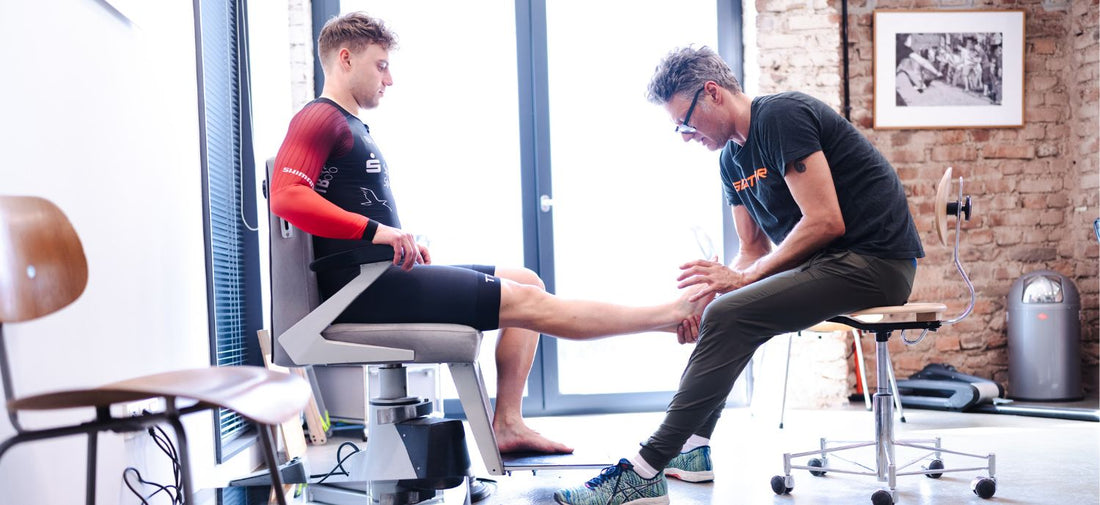
Achilles pain after cycling
Achilles pain after cycling is a common complaint among both amateur and professional cyclists. This discomfort, often felt near the heel or lower calf, can affect performance and even lead to long-term injury if ignored. In this guide, we’ll break down what causes Achilles tendon pain in cyclists, how to manage it, and how cycling insoles like SOLESTAR can help.
What is Achilles tendon pain in cyclists?
Achilles tendon pain is inflammation or irritation of the tendon that connects your calf muscles to your heel bone. For cyclists, this pain can build gradually or strike suddenly after long or intense rides.
Symptoms
Typical symptoms of Achilles pain include:
- A dull or sharp pain at the back of the ankle
- Swelling or tenderness near the heel
- Tightness in the calf or Achilles area
- Stiffness, especially in the morning or after resting
- Discomfort when pointing the toes or pushing off the pedal
This pain may intensify during or after cycling sessions, particularly if the muscles are fatigued or overused.

Why Achilles pain develops during or after rides
Cycling involves repetitive ankle and calf movement. Poor biomechanics, improper bike setup, or fatigue can overload the Achilles tendon. As a result, the tendon becomes strained, leading to inflammation and microtears. Over time, this results in chronic discomfort, especially if recovery strategies aren’t in place.
Main Causes of Achilles Pain While Cycling
Achilles issues in cyclists are often linked to a few key factors:
- Incorrect cleat position, especially too far forward or with excess float
- Overtraining or sudden increase in ride volume
- Poor saddle height, particularly when too high, forcing toe pointing
- Weak or tight calf muscles and limited ankle mobility
- Lack of proper recovery and stretching routines
- Improper foot support, causing poor biomechanics and overload on the tendon
Addressing these root causes is essential to relieving pain and preventing recurrence.
Tips to Reduce Achilles Pain
Small adjustments in your gear and routine can make a big difference.
Lower the saddle slightly to reduce strain
A saddle that’s too high can force you to overextend your ankle at the bottom of each pedal stroke, increasing tension on the Achilles tendon. Lowering the saddle slightly helps maintain a more neutral foot position and reduces the strain on your calves and heel area.
Adjust cleats to limit ankle range of motion
Cleats that allow too much float or are positioned too far forward can increase strain on the Achilles. Try moving them slightly backward and limiting float to reduce unnecessary ankle movement during pedaling.
Stretch calves and Achilles after the ride
Post-ride stretches help maintain flexibility and reduce tension in the calf and Achilles area. Focus on static calf stretches, heel drops on a step, and foam rolling to release tight tissue.

Do Insoles Help With Achilles Pain in Cycling?
Yes, the right cycling insoles can significantly reduce Achilles pain by improving biomechanics and supporting proper alignment.
- Insoles improve foot stability and posture: This reduces unnecessary movement and allows for more efficient power transfer through the pedal stroke.
- They support the heel and reduce overextension stress: With proper heel support, the tendon is less likely to be overstretched during the upstroke or when pushing down aggressively.
- They align the lower limb chain: Insoles promote better alignment from foot to hip, which minimizes compensatory movements that often strain the Achilles.
Best Insoles to Reduce Achilles Pain
When it comes to cycling-specific insoles, SOLESTAR stands out as a trusted solution among performance cyclists.
SOLESTAR cycling insoles are designed with:
- A rigid core for maximum support
- Anatomical arch structure that stabilizes the foot in every pedal stroke
- A deep heel cup that keeps the heel aligned and reduces unwanted movement
- A design developed specifically for cycling biomechanics, not general use
By using SOLESTAR insoles, cyclists can address one of the key causes of Achilles pain: poor foot stability and posture on the bike.

Conclusion
Achilles pain after cycling shouldn’t be ignored. By understanding the causes and making smart adjustments from cleat positioning to calf stretching and supportive insoles, you can relieve discomfort and prevent future injury. For long-term performance and protection, SOLESTAR cycling insoles offer one of the most effective solutions to support your Achilles and ride pain-free.

